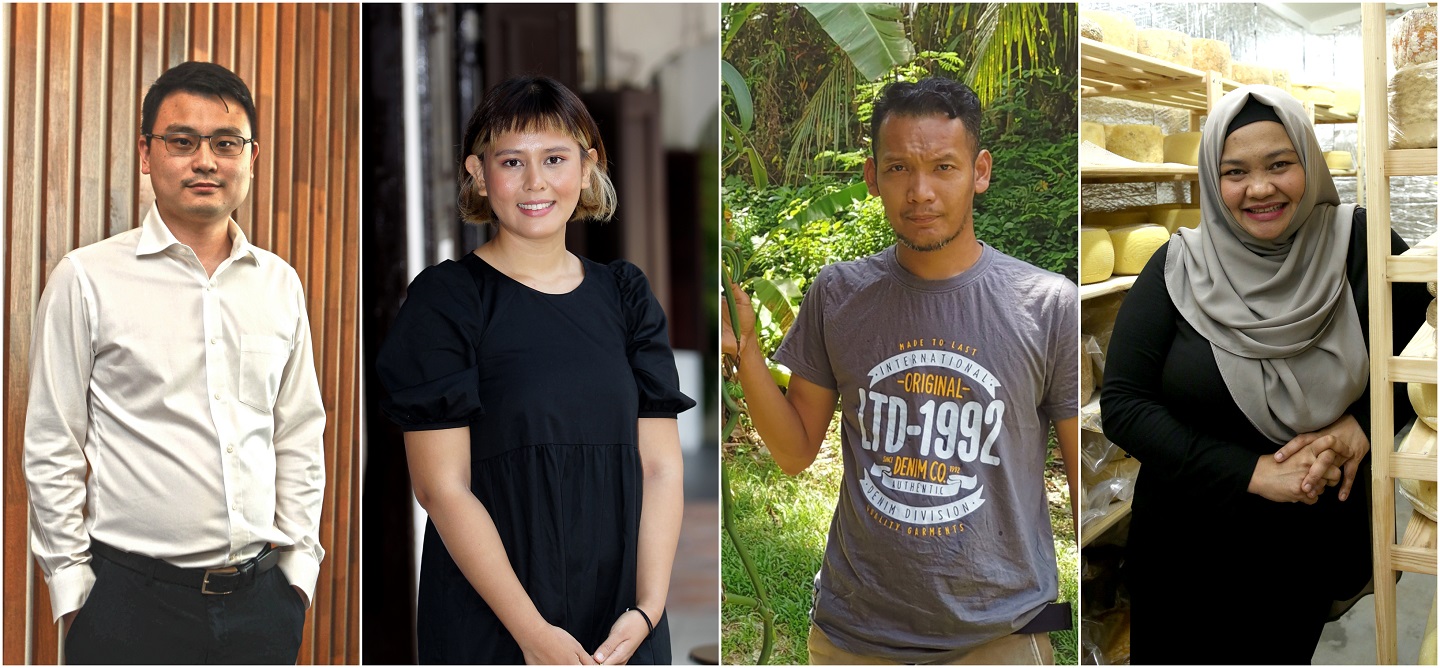
From left: Managing director AJ Lim (T’lur Caviar); managing director Nona Zainuddin (Seniman Kakao); vanilla farmer Mohd Feisal Mohd Norawi (Amani Vanilla Temerloh); Annisa Iwan (Milky Whey Cheese).
Black gold: T’lur Caviar
Sturgeon can only survive in subtropical climates. Fact? Perhaps not. T’lur Caviar has a farm in Tanjung Malim, Perak, and its sturgeon are thriving but this did not happen overnight. R&D started in 2008 and the farm was finally able to sustain the life of the fish in 2011. “During that time, we engaged a lot of experts overseas and they told us not to waste our time and that it was impossible to farm sturgeon in Malaysia due to the weather,” says managing director AJ Lim.
Foreign — Russian, German and American — methods of farming often do not work due to the local environment. The team at T’lur Caviar then decided to reach out to local aquaculture experts who farm fish such as catfish and tilapia, after which they began implementing local practices, which worked like a charm. While the original plan was to sell only fish meat, after a little more experimenting, they decided to venture into caviar production...
Behind the bar: Seniman Kakao
Artistry, when applied to chocolate, suggests the confectionery equivalent of a winemaker — the ability to influence a raw product so that its notes sing true. After their success at coffee specialist Artisan Roastery, Michael Wilson and Amira Mohamad established chocolate bean-to-bar label Seniman Kakao in 2015 to experiment with applying their roasting know-how to cocoa.
“We quickly discovered that cocoa is a lot more complicated,” laughs managing director Nona Zainuddin, who has helmed both businesses since the husband-and-wife founding team left to settle permanently in New Zealand. “Most chocolate is quite straightforward, with little nuance. Roasting alters their flavour profiles. We do that well thanks to our experience with coffee, but what we really want to highlight is the quality and diversity of the cocoa beans themselves...
The flavour of success: Amani Vanilla Temerloh
Although vanilla is a flavouring most often used in western desserts, the lush flowering vines that yield the precious vanilla pods grow best in the humid weather more often associated with the tropics. Delicate, light green orchid blooms precede the arrival of the pods, and harvest occurs about nine months after pollination.
The world’s largest vanilla-producing countries include Madagascar, Mexico, Tahiti and neighbouring Indonesia, particularly Flores. Despite having the perfect conditions for vanilla to thrive, Malaysia is not a producer — and Pahang-based vanilla farmer Mohd Feisal Mohd Norawi is determined to change this. “Apart from my farm, there is another one in Sabah, so there is a huge opportunity here. Malaysia is currently not on the radar screen for vanilla farming but there is no reason why we can’t become a major producer and add to our agricultural portfolio,” he says eagerly...
To Brie or not to Brie: Milky Whey Cheese
Invisible forces are at work as we step into Annisa Iwan’s cheese cave wearing hairnets and protective boots. Sitting on wooden beams, blocks of cheese bear telltale signs of mould and maturity as they age towards the apex of delectability. Here, bacteria, or “starter cultures” that are added to milk to induce the fermentation process, go to town.
Bacterial culture and rennet, an enzyme used to coagulate milk, only make up two-thirds of the triumvirate of ingredients in cheese-making. The most important element is, of course, quality milk. Having no cows of her own, Annisa sources milk from a local farm in Perak where Jersey cows feed on corn and elephant grass, whose young leaves and shoots can be cooked in stews and soups. She makes cheese at least three times a week but maintains the wheels in the cave daily by flipping, cleaning and brushing them...
---
To read the full version of all four businesses, pick up a copy of The Edge Malaysia (Nov 11, 2019) at your nearest news stand. Save by subscribing to us for your print and/or digital copy.


